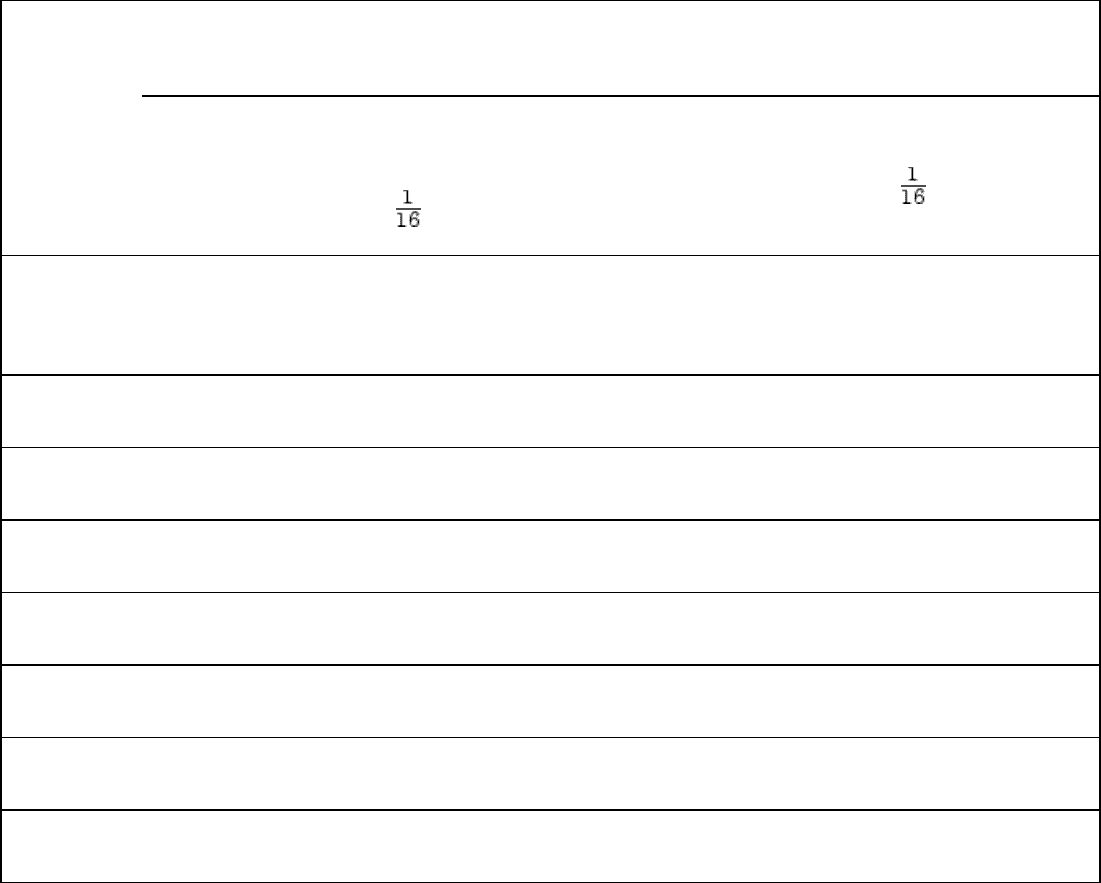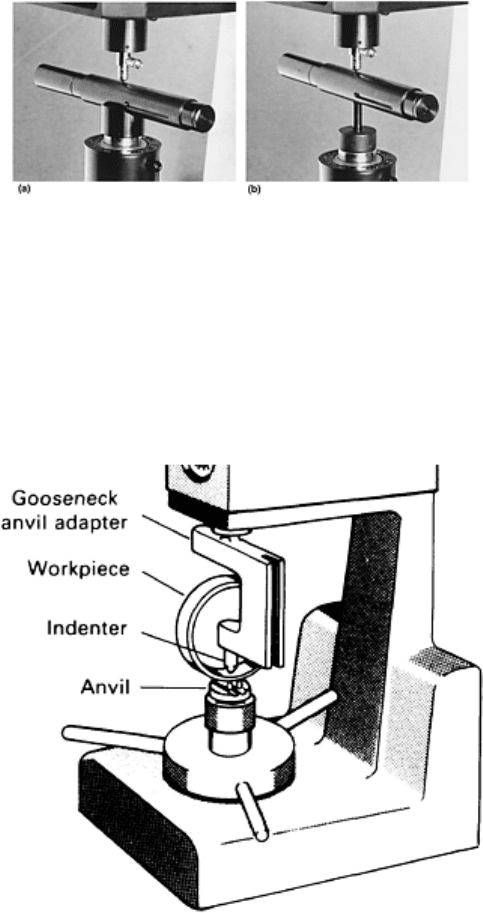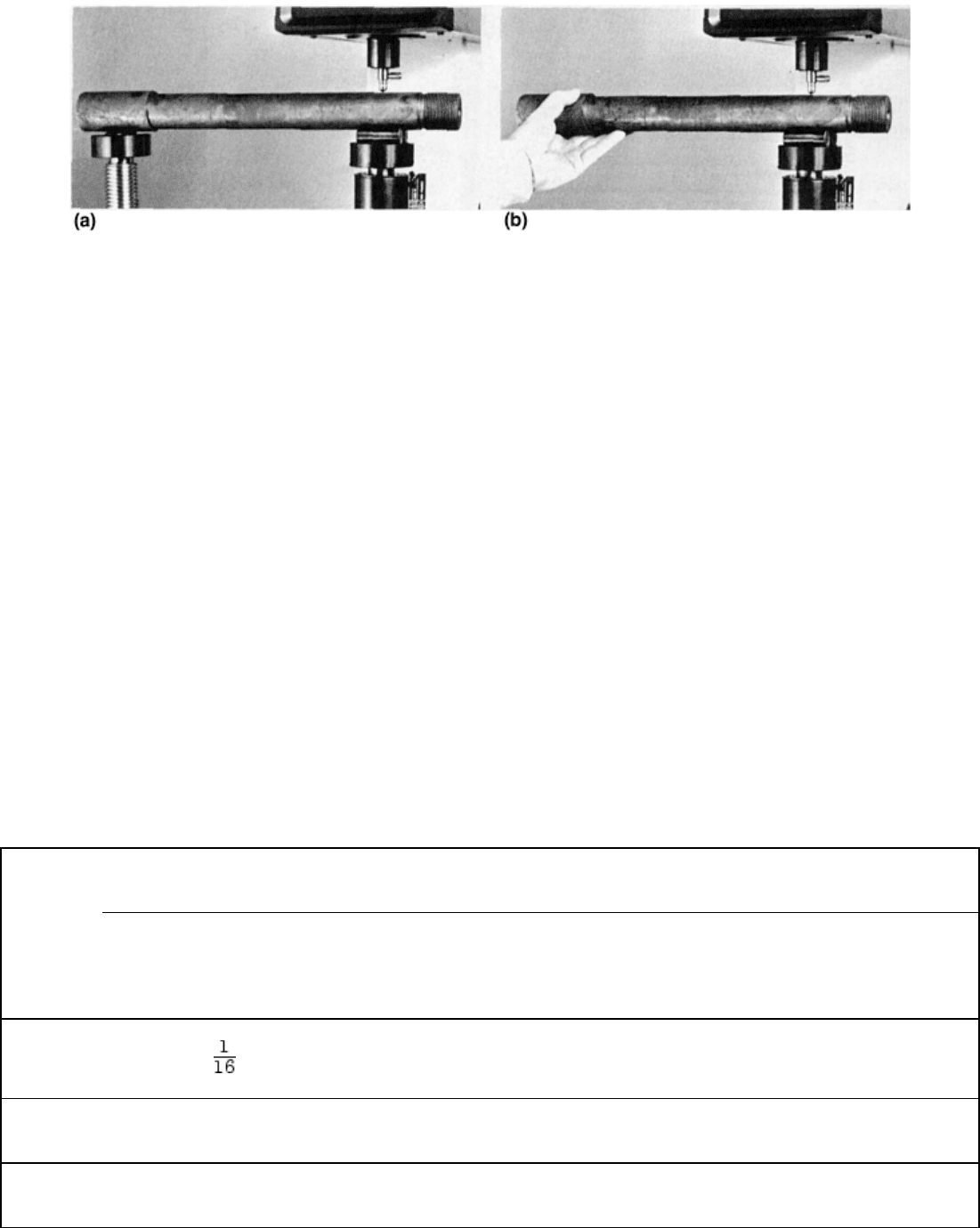ASM Metals HandBook Vol. 8 - Mechanical Testing and Evaluation
Подождите немного. Документ загружается.


Depth = (130 - 80) × 0.002 mm = 0.10 mm
In Rockwell superficial testing, regardless of the type of indenter used, one number represents an indentation of 0.001 mm
(0.00004 in.). Therefore, a reading of 80 HR30N indicates an increase in depth of indentation from preliminary to total
force of:
Depth = (100 - 80) × 0.001 = 0.02 mm
Generally, depth computation is not necessary because minimum thickness values have been calculated (Table 3). These
minimum thickness values follow the 10-to-1 ratio for scales using the diamond indenter and 15-to-1 using the ball
indenters. It should also be noted that the initial indentation from the preliminary force is not included in these
calculations.
Table 3 Minimum work metal hardness values for testing various thicknesses of metals with
standard and superficial Rockwell hardness testers
Minimum hardness for standard testers at indicated
scale and load (in kgf)
Minimum hardness for superficial testers at
indicated scale and load (in. kgf)
Metal
thickness
Diamond indenter Ball indenter (1.59 mm,
or
in., diam)
Diamond indenter Ball indenter (1.59 mm,
or in., diam)
mm in. A
(60)
D
(100)
C
(150)
F
(60)
B
(100)
G
(150)
15N
(15)
30N
(30)
45N
(45)
15T
(15)
30T
(30)
45T
(45)
0.152 0.006 92 … … … … … 92 … … … … …
0.203 0.008 90 … … … … … 90 … … … … …
0.254 0.010 … … … … … … 88 … … 91 … …
0.305 0.012 … … … … … … 83 82 77 86 … …
0.356 0.014 … … … … … … 76 78.5 74 81 80 …
0.406 0.016 86 … … … … … 68 74 72 75 72 71
0.457 0.018 84 … … … … … … 66 68 68 64 62

Minimum hardness for standard testers at indicated
scale and load (in kgf)
Minimum hardness for superficial testers at
indicated scale and load (in. kgf)
Metal
thickness
Diamond indenter Ball indenter (1.59 mm,
or
in., diam)
Diamond indenter Ball indenter (1.59 mm,
or in., diam)
mm in. A
(60)
D
(100)
C
(150)
F
(60)
B
(100)
G
(150)
15N
(15)
30N
(30)
45N
(45)
15T
(15)
30T
(30)
45T
(45)
0.508 0.020 82 77 … 100 … … … 57 63 … 55 53
0.559 0.022 78 75 69 … … … … 47 58 … 45 43
0.610 0.024 76 72 67 98 94 94 … … 51 … 34 31
0.660 0.026 71 68 65 91 87 87 …
(a)
…
(a)
… 18
0.711 0.028 67 63 62 85 … 76 … … … … … 4
0.762 0.030 60 58 57 77 71 68 … … 26 … … …
0.813 0.032 … 51 52 69 62 59 … … 20 … … …
0.864 0.034
(a)
43 45 … 52 50 … …
(a)
… 43 …
0.914 0.036 … … 37 … 40 42 … … … … 40 …
0.965 0.038 … … 28 … 28 31 … … … … 36 …
1.016 0.040 … … … … … 22 … … … … 33 …
1.066 0.042 … … … … … … … … … … 29 …
1.116 0.044 … … … … … … … … … …
(a)
…
1.166 0.046 … … … … … … … … … … … …
1.216 0.048 … … … … … … … … … … … …

Minimum hardness for standard testers at indicated
scale and load (in kgf)
Minimum hardness for superficial testers at
indicated scale and load (in. kgf)
Metal
thickness
Diamond indenter Ball indenter (1.59 mm,
or
in., diam)
Diamond indenter Ball indenter (1.59 mm,
or in., diam)
mm in. A
(60)
D
(100)
C
(150)
F
(60)
B
(100)
G
(150)
15N
(15)
30N
(30)
45N
(45)
15T
(15)
30T
(30)
45T
(45)
1.270 0.050 … … … … … … … … … … … …
1.321 0.052 …
(a)
… … … … … … … … … …
1.372 0.054 … … … … … … … … … … … …
1.422 0.056 … … … … … … … … … … … …
1.473 0.058 … … … … … … … … … … … …
1.524 0.060 … … … … … … … … … … … …
1.575 0.062 … … … … … … … … … … …
(a)
1.626 0.064 … … … … … … … … … … … …
1.676 0.066 … …
(a)
… … … … … … … … …
1.727 0.068 … … … … … … … … … … … …
1.778 0.070 … … … … … … … … … … … …
1.829 0.072 … … … … … … … … … … … …
1.880 0.074 … … … … … … … … … … … …
1.930 0.076 … … … … … … … … … … … …
1.981 0.078 … … … … … … … … … … … …

Minimum hardness for standard testers at indicated
scale and load (in kgf)
Minimum hardness for superficial testers at
indicated scale and load (in. kgf)
Metal
thickness
Diamond indenter Ball indenter (1.59 mm,
or
in., diam)
Diamond indenter Ball indenter (1.59 mm,
or in., diam)
mm in. A
(60)
D
(100)
C
(150)
F
(60)
B
(100)
G
(150)
15N
(15)
30N
(30)
45N
(45)
15T
(15)
30T
(30)
45T
(45)
2.032 0.080 … … … … … … … … … … … …
2.083 0.082 … … … … … … … … … … … …
2.134 0.084 … … … … … … … … … … … …
2.184 0.086 … … … … … … … … … … … …
2.235 0.088 … … … … … … … … … … … …
2.286 0.090 … … … … … … … … … … … …
2.337 0.092 … … … … … … … … … … … …
2.388 0.094 … … … … … … … … … … … …
2.438 0.096 … … … … … … … … … … … …
2.489 0.098 … … … … … … … … … … … …
2.540 0.100 … … … … … … … … … … … …
Note: These values are approximate only and are intended primarily as a guide. Material thinner than shown should be
tested with a microindentation hardness tester. The thickness of the workpiece should be at least 1.5 times the diagonal of
the indentation when using a Vickers indenter, and at least 0.5 times the long diagonal when using a Knoop indenter.
(a) No minimum hardness for metal of equal or greater thickness
Example: Scale Selection for Thin Steel Strip. Consider a requirement to check the hardness of 0.36 mm
(0.014 in.) thick steel strip with a suspected hardness of 63 HRC. According to Table 3, material in this hardness range
must be approximately 0.71 mm (0.028 in.) thick for an accurate Rockwell C test. Therefore, 63 HRC must be converted
to an approximate equivalent hardness on other Rockwell scales. These hardness values taken from a conversion table are
82.8 HRA, 73 HRD, 69.9 HR45N, 80.1 HR30N, and 91.4 HR15N. (See the article “Hardness Conversions for Steels” in
this Volume.)
Referring to Table 3, only three Rockwell scales—45N, 30N, and 15N—are appropriate for testing this hardened 0.36
mm (0.014 in.) thick material. The 45N scale is unsuitable because the material should be at least 72 HR45N. The 30N
scale requires the material to be 64 HR30N; on the 15N scale, the material must be at least 70 HR15N. Therefore, either
the 30N or 15N scale should be used.
If a choice remains after all the criteria have been applied, then the scale applying the heaviest force should be used. A
heavier force produces a larger indentation covering a greater portion of the material and a better representation of the
material as a whole. In addition, the heavier the force, the greater the sensitivity of the scale. In this example, a conversion
chart indicates that, in the hard steel range, a difference in hardness of one Rockwell number in the 30N scale represents
just one-half of a point on the 15N scale. Therefore, smaller differences can be detected when using the 30N scale. This
approach also applies when selecting a scale to accurately measure hardness when approximate case depth and hardness
are known.
Anvil Effect. Minimum thickness charts and the 10-to-1 ratio serve only as guides. After determining which Rockwell
scale should be used based on minimum thickness values, an actual test should be performed, and the specimen side
opposite the indentation should be examined for any marking, bulging, or disturbed material; these indicate that the
material is not thick enough for the applied force. This condition is known as “anvil effect.” When anvil effect or material
flow restriction is encountered, the Rockwell value may not be correct and should be considered an invalid test. The
Rockwell scale applying the lower force should be used.
Use of several specimens or stacking is not recommended. Slippage between the contact surfaces of the specimens makes
a valid test impossible to obtain. The only exception is when testing plastics. The use of several thicknesses for
elastomeric materials when anvil effect is present is considered in ASTM D 785 (Ref 2). Testing performed on soft
plastics does not have an adverse effect when the test specimen is composed of a stack of several pieces of the same
thickness, provided that the surfaces are in total contact and not held apart by sink marks, burrs from saw cuts, or any
protrusions that would permit an air gap between the pieces.
When testing specimens from which the anvil effect results, the condition of the supporting surface of the anvil should be
inspected. After several tests, this surface can become marred or indented. Either condition will have adverse results with
Rockwell testing, because under the total force, the test material will sink into the indentation in the anvil and a lower
reading will result. If the anvil surface shows any damage it should be replaced or relapped.
When using a ball indenter and a superficial scale of 15 kgf on a specimen in which anvil effect or material flow is
present, a diamond spot anvil is used in place of the hardened steel anvil. Under these conditions, the diamond surface is
not likely to be damaged when testing thin materials. Furthermore, with materials that flow under load, the hard polished
diamond surface provides a more uniform frictional condition with the underside of the specimen, which improves
repeatability of readings. These results should be used in a comparative manner inasmuch as they may not be the same as
those obtained with a steel anvil.
Workpiece Size and Shape
Specimen size and configuration may require modification in the test setup for some indentation-type testing. For
example, large specimens and thin-wall rings or tubing may need additional support equipment as well as correction
factors for curved surfaces. A few examples and illustrations are provided here.
Workpiece Size. For large workpieces that are not easily transported to the stationary testers, the logical procedure is
to take the testers to the workpiece. Portable machines often are used for onsite testing of workpieces that are too large
and/or unwieldy to transport to the tester. In many applications where on-site testing is required, the Scleroscope can be a
great advantage. Likewise, ultrasonic instruments can be used for on-site testing. When using either Scleroscope or
ultrasonic testing, however, surface condition is critical to obtaining accurate results. Neither method is well suited for
testing cast irons.
Many specially designed Rockwell hardness testers also have been developed to accommodate the testing of unusually
large specimens, such as railroad car wheels and large turbine blades that cannot be conveniently brought to or placed in a
bench-type tester. Figure 2 shows an example of a Rockwell tester for large parts. For large and heavy workpieces or
workpieces of peculiar shape, a large support table may be required.

Fig. 2 Rockwell tester for large parts
Shape of the Workpiece. The ideal shape for hardness testing is a square block of sufficient size to permit making
any kind of indentation required. Such ideal conditions seldom exist, and arrangements must be made to accommodate a
variety of shapes.
The first step in dealing with different shapes is to have a variety of anvils for either Rockwell or Brinell testing. Several
options exist for dealing with unwieldy parts (long shafts, for instance). The use of outboard supports or counter-weights
are two possibilities. Another approach is to use a type of tester that firmly clamps the workpiece before the load is
applied.
Cylindrical Shapes. Round ringlike parts often are tested by using special adapters or specially designed instruments.
Cylindrical parts can be tested accurately by either the Brinell or Rockwell method with the use of correction factors. In
Brinell testing of cylindrical surfaces an oval indentation results, but this can be corrected to a reasonable degree by
obtaining the average of four optical readings taken at 45° apart.

When testing cylindrical pieces, such as rods, the shallow V or standard V anvil should be used, and the test should be
applied over the axis of the rod. Care should be taken that the specimen lies flat, supported by the sides of the V anvil.
Figure 3 illustrates correct and incorrect methods of supporting cylindrical work for testing.
Fig. 3 Anvil support for cylindrical workpieces. (a) Correct method places the specimen centrally
under indenter and prevents movement of the specimen under testing loads. (b) Incorrect method
of supporting cylindrical work on spot anvil. The testpiece is not firmly secured, and rolling of the
specimen can cause damage to the indenter or erroneous readings
Inner Surfaces. The most common approach to Rockwell testing of inner surfaces is to use a gooseneck adapter for
the indenter (Fig. 4). This method can be used to test inner surfaces as small as 11.11 mm (0.4375 in.) in diameter or
height. Many of the smaller gooseneck adapters can be used with any tester; larger units may require a special gooseneck
tester.
Fig. 4 Setup for hardness testing of inner surfaces of cylindrical workpieces using a gooseneck
adapter
Thin-Wall Rings or Tubes. When testing thin-wall rings or tubing that may not support the applied force and
therefore deform permanently, a test should be made to determine if this condition exists. If the specimen is permanently
deformed, either an internal mandril on a gooseneck anvil and/or a lighter force should be used. Excessive deformation of
tubing (either permanent or temporary) can affect the application of the total force. If through deformation the indenter
travels to its full extent, complete application of the applied force may not be achieved and an inaccurately high reading
will result.
Gears and other complex shapes often require the use of relatively complex anvils and related holding fixtures.
When testing workpieces that have complex shapes, for example testing on the pitch line of gear teeth, a specially
designed anvil or fixture usually is required. In some cases a specially designed tester may be required. Portable testers
may work well for testing large, odd-shaped parts.
Long Specimens. When a workpiece has excessive overhang because of its configuration and cannot be firmly held
by the application of the preliminary force, additional support must be used to ensure that the surface to be tested is
perpendicular to the indenter axis and that the workpiece will not move during testing. Because manual support is not

practical, a jack-rest should be provided at the overhang end for adequate support. Figure 5 illustrates the correct and
incorrect methods for testing long, heavy workpieces.
Fig. 5 Method for mounting and testing long, heavy workpieces. (a) Correct method requires a
support of the extended end of the piece to prevent any pressure of specimen against indenter. The
jack-rest support is available as an accessory. (b) Incorrect method causes damage to indenter and,
through leverage action, causes drag and jamming of plunger rod, producing inaccurate readings.
When testing, the specimen must be pressed rigidly on the anvil by the pressure of the minor load.
Because of this, only short or lightweight material may be permitted much overhang.
Correction Factors for Workpieces with Curved Surfaces. When an indenter is forced into a convex
surface, there is less lateral support supplied for the indenting force; consequently, the indenter will sink deeper into the
material than it would into a flat surface of the same hardness. Therefore, for convex surfaces, lower hardness values will
result. The opposite is true for concave surfaces because additional lateral support is provided, resulting in higher
hardness values than when testing the same hardness material with a flat surface.
Results from tests made on a curved surface may be in error and should not be reported without stating the radius of
curvature. For Brinell testing, the radius of curvature of the surface shall be greater than 2.5 times the diameter of the
indenter. For Rockwell testing diameters of more than 25 mm (1 in.), the difference is negligible. For diameters less than
25 mm (1 in.), particularly for softer materials that involve larger indentations, the curvature, whether convex or concave,
must be taken into account if a comparison is to be made with different diameters or with a flat surface.
Correction factors should be applied when workpieces are expected to meet specified values. Typical correction factors
for regular and superficial Rockwell hardness values are given in Table 4. The correction values are added to the hardness
value when testing convex surfaces and subtracted when testing concave surfaces. On cylinders with diameters as small
as 6.35 mm (0.25 in.) regular Rockwell scales may be used; for superficial Rockwell testing, correction factors as small as
3.175 mm (0.125 in.) are given in Table 4.
Table 4 Correction factors for cylindrical workpieces tested with standard and superficial Rockwell
hardness testers
Correction factor for workpiece with diameter of: Observed
reading
3.175 mm
(0.125 in.)
6.350 mm
(0.250 in.)
9.525 mm
(0.375 in.)
12.700 mm
(0.500 in.)
15.875 mm
(0.625 in.)
19.050 mm
(0.750 in.)
22.225 mm
(0.875 in.)
25.400 mm
(1.000 in.)
Standard hardness testing, in. (1.588 mm) ball indenter (Rockwell B, F, and G scales)
100 … 3.5 2.5 1.5 1.5 1.0 1.0 0.5
90 … 4.0 3.0 2.0 1.5 1.5 1.5 1.0

Correction factor for workpiece with diameter of: Observed
reading
3.175 mm
(0.125 in.)
6.350 mm
(0.250 in.)
9.525 mm
(0.375 in.)
12.700 mm
(0.500 in.)
15.875 mm
(0.625 in.)
19.050 mm
(0.750 in.)
22.225 mm
(0.875 in.)
25.400 mm
(1.000 in.)
80 … 5.0 3.5 2.5 2.0 1.5 1.5 1.5
70 … 6.0 4.0 3.0 2.5 2.0 2.0 1.5
60 … 7.0 5.0 3.5 3.0 2.5 2.0 2.0
50 … 8.0 5.5 4.0 3.5 3.0 2.5 2.0
40 … 9.0 6.0 4.5 4.0 3.0 2.5 2.5
30 … 10.0 6.5 5.0 4.5 3.5 3.0 2.5
20 … 11.0 7.5 5.5 4.5 4.0 3.5 3.0
10 … 12.0 8.0 6.0 5.0 4.0 3.5 3.0
0 … 12.5 8.5 6.5 5.5 4.5 3.5 3.0
Standard hardness testing, diamond indenter (Rockwell C, D, and A scales)
80 … 0.5 0.5 0.5 … … … …
70 … 1.0 1.0 0.5 0.5 0.5 … …
60 … 1.5 1.0 1.0 0.5 0.5 0.5 0.5
50 … 2.5 2.0 1.5 1.0 1.0 0.5 0.5
40 … 3.5 2.5 2.0 1.5 1.0 1.0 1.0
30 … 5.0 3.5 2.5 2.0 1.5 1.5 1.0
20 … 6.0 4.5 3.5 2.5 2.0 1.5 1.5

Correction factor for workpiece with diameter of: Observed
reading
3.175 mm
(0.125 in.)
6.350 mm
(0.250 in.)
9.525 mm
(0.375 in.)
12.700 mm
(0.500 in.)
15.875 mm
(0.625 in.)
19.050 mm
(0.750 in.)
22.225 mm
(0.875 in.)
25.400 mm
(1.000 in.)
Superficial hardness testing, in. (1.588 mm) ball indenter (Rockwell 15T, 30T, and 45T scales)
90 1.5 1.0 1.0 0.5 0.5 0.5 … 0.5
80 3.0 2.0 1.5 1.5 1.0 1.0 … 0.5
70 5.0 3.5 2.5 2.0 1.5 1.0 … 1.0
60 6.5 4.5 3.0 2.5 2.0 1.5 … 1.5
50 8.5 5.5 4.0 3.0 2.5 2.0 … 1.5
40 10.0 6.5 4.5 3.5 3.0 2.5 … 2.0
30 11.5 7.5 5.0 4.0 3.5 2.5 … 2.0
20 13.0 9.0 6.0 4.5 3.5 3.0 … 2.0
Superficial hardness testing, diamond indenter (Rockwell 15N, 30N, and 45N scales)
90 0.5 0.5 … … … … … …
85 0.5 0.5 0.5 … … … … …
80 1.0 0.5 0.5 0.5 … … … …
75 1.5 1.0 0.5 0.5 0.5 0.5 … …
70 2.0 1.0 1.0 0.5 0.5 0.5 … 0.5
65 2.5 1.5 1.0 0.5 0.5 0.5 … 0.5
60 3.0 1.5 1.0 1.0 0.5 0.5 … 0.5
